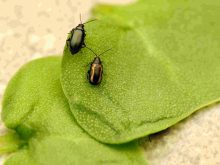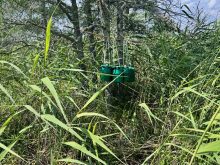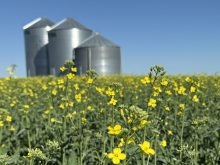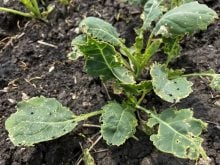Seed treatments should protect canola if it reaches the three- to four-leaf stage within three to four weeks of seeding
What’s tiny, loves heat, eats away at farm profits and is enough to keep you awake at night?
Flea beetles, of course.
In the spring of 2021, the pests caused headaches and sleepless nights for canola growers across Western Canada.
But according to John Gavloski, provincial entomologist with Manitoba Agriculture, there’s a reliable way to keep flea beetle damage to a minimum without resorting to post-emergent foliar sprays.
The key, said Gavloski, is to ensure your canola crop gets off to a good start.
Read Also

Canola oil transloading facility opens
DP World just opened its new canola oil transload facility at the Port of Vancouver. It can ship one million tonnes of the commodity per year.
“If, by chance, you can get to the three- to four-leaf stage of growth within about three to four weeks of seeding, then seed treatment should be enough to protect you from flea beetles,” he said.
“But if the seed, for whatever reason, takes some time to germinate or if the seedlings are really struggling throughout that seedling stage, then often those seed treatments alone aren’t enough and people will have to do foliar spraying.”
In a recent web presentation during the online Farm Forum event, Gavloski offered tips on how to limit flea beetle damage without foliar sprays.
Seed treatments that are used on all commercially available canola varieties can be an effective line of defence, he said.
But getting crops off to a quick start is critical.
In the past, some canola growers have experimented with ultra early seeding dates.
The hope was that early-seeded canola crops would reach the flowering stage earlier in the season and avoid yield losses caused by heat blast.
However, seeding too early in the season or into cold soils can leave canola seedlings more vulnerable to flea beetle damage, especially if it takes too long for seedings to reach that critical three- or four-leaf stage.
In a Dec. 7 presentation during Farm Forum, Gavloski said 2021 was a difficult year for canola seedling development.
Dry conditions across Western Canada were not conducive to rapid germination and seedling development.
Many canola crops took much longer than four weeks to go from seeding date to the three- or four-leaf stage.
Thin canola stands mean less margin for error for flea beetles.
For that reason, flea beetle damage was common and foliar applications were required in many areas.
In some parts of Manitoba, as many as four foliar applications were required.
“This past year, we had some really dry conditions … we had very little snowfall and we had a very dry spring,” Gavloski said.
“That’s one of the reasons why we did have so many (flea beetle problems) was it just took so long for canola to get going.”
In dry years, growers may benefit from delaying their seeding date.
If soils are warm and growers wait for a good soaking rain before seeding canola, germination and seedling development can occur quickly, meaning seed treatments alone should provide adequate protection.
“That strategy of delaying seeding and waiting for more conducive conditions — that can work, but it doesn’t always work,” Gavloski said.
Some studies conducted in Western Canada suggest that earlier seeded canola crops are generally more prone to flea beetle damage.
Based on this, canola seeding dates of mid-May rather than early-May or late April might minimize flea beetle damage and reduce the need for foliar sprays.
“Really, what it boils down to is, again, you need to get your plants from seeding date to the four-leaf stage in three to four weeks,” Gavloski repeated.
“In some years, delaying a little bit so that you’re seeding into warmer soil and moist soil might do the trick and produce the result that you want.”
Late-season flea beetles no cause for alarm.
Gavloski said he received a call from an agronomist last spring who was wondering why flea beetle damage appeared to be less evident in canola crops that were direct-seeded into cereal stubble.
In another case, a grower contacted Gavloski and told him that flea beetle damage was almost non-existent on untreated volunteer canola seedlings that were growing in his wheat crop.
Across the road, meanwhile, flea beetles were busily feasting on canola seedlings that were planted with treated seed.
The answer to those riddles might have something to do with the micro-climatic conditions within the field.
Flea beetles prefer a calm, open environment with plenty of heat and sunlight.
Obstacles such as stubble or cereal plants might be enough to prompt flea beetles to seek out more preferable feeding conditions elsewhere, even if it means crossing the road.
Cover crops may replicate zero till for flea beetle control.
“There’s been several studies actually looking at the link between direct seeding and flea beetle damage,” Gavloski said.
“What they suspect is happening is that direct seeding is providing a bit of a micro-climate that flea beetles don’t quite like as much.
“So direct seeding into stubble can help somewhat but I do caution you, when flea beetle (numbers) are really high, you still need to watch that canola, direct seeded or not.”


















